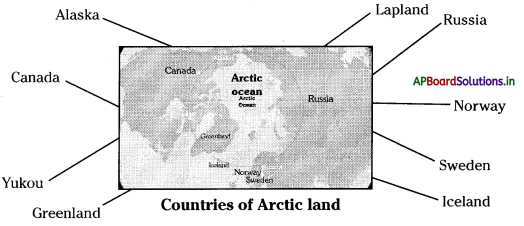Students can go through AP State Board 8th Class Social Studies Notes Chapter 4 The Polar Regions to understand and remember the concept easily.
AP State Board Syllabus 8th Class Social Studies Notes Chapter 4 The Polar Regions
→ The region which lies near the poles is called the polar region.
→ The boundary of the polar region is known as the ‘Arctic Circle’.
→ The Tundra region has a unique type of vegetation known as ‘Tundra Vegetation’.
→ In this region, it is extremely cold. Since the Sun does not go high up in the sky, it is never very warm.
→ Most of the region is treeless.
→ The most commonly accepted meaning of “Eskimos” is “Snowshoe-netter”.
→ Hunting seals and fishing are the primary occupations of the Eskimos.
→ Their food is related to the nature of the atmosphere.
![]()
→ Their houses are known as “Igloos”.
→ The Eskimos believe that spirits control the things like life, health, sickness, starvation, and death.
→ They had no relations with the rest of the world.
→ The pattern of relationships between the Eskimos and outsiders has been described as “boom and bust”.
→ Arctic Circle: The 66\(\frac{1}{2}\)N latitude on the globe is known as Arctic Circle.
→ Tundra Vegetation: The Tundra region gets very little sunlight, it has a unique type of vegetation known as the ‘Tundra Vegetation’.
→ Icebergs: During summer the lakes fill up, and huge chunks of ice break off and float into the ocean as icebergs.
→ Eskimos: The people who live in scattered settlements in Greenland, Canada, Alaska, and Síberia.
![]()
→Kayaks: Kayaks are small canoe-like boats made of animal skins stretched over a wooden frame.
→Igloo: ‘Igloo’ means house in the language of Eskimos.
